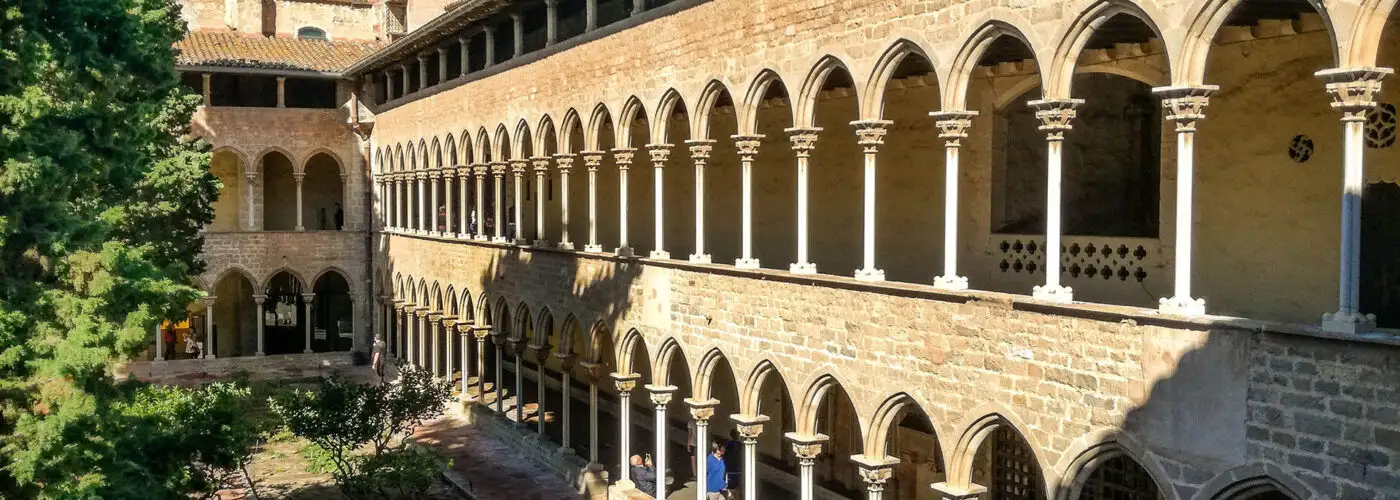On the first day of a recent trip to Barcelona, Spain, I found myself elbow to elbow with a mob of fellow tourists outside Antoni Gaudi’s Casa Batllo, one of the city’s most famous attractions. A few hours later, I shouldered through the hordes at a Christmas market in front of the cathedral. And the next day I discovered a line stretching out the door of the Basilica in Montserrat (a popular day trip from Barcelona), where hundreds of travelers waited to touch the hand of the revered Black Madonna. I’d hoped to miss out on crowds by traveling in early December, part of Spain’s winter low season, but that wasn’t the case—with one exception.
During an hour and a half at Pedralbes Monastery, located in a leafy residential area just a 15-minute subway ride from the center of the city, I wandered through the world’s largest Gothic cloister, peered into small cells where nuns once embroidered and prayed, and marveled over a chapel adorned with colorful 14th-century frescoes. The best part? I had this serene spot almost entirely to myself.
Known in Catalan as Reial Monestir de Santa Maria de Pedralbes, the monastery was founded in 1327 by Queen Elisenda de Montcada as a home for the Poor Clare Sisters, an order of Franciscan nuns. While the sisters lived lives of quiet contemplation, they also accumulated a surprising number of religious treasures, from altarpieces and alabaster sculptures to gold and silver chalices. (My favorite? The massive, richly illustrated choir books.) Many of these artifacts are on display under the vaulted ceiling of what was once the nuns’ dormitory.
As you walk through the monastery, you’ll see the sepulcher of Queen Elisenda, the refectory where the nuns took their meals, the abbey room (the oldest part of the building), and even the kitchen, where I loved the colorful tiles added in the 19th century. It’s easy to imagine what life may have been like here, especially when you stand in the center of the cloister with its trees, fountains, and medicinal garden. It’s a perfect place for quiet contemplation—and a balm to anyone seeking to escape the crowds at Barcelona’s top tourist spots.
How to Get to Pedralbes Monastery
To reach the monastery, you can take the FGC train (which connects easily to the Metro) from Placa Catalunya to the Reina Elisenda station, a 10- to 15-minute walk from Pedralbes. Barcelona’s hop-on, hop-off bus and several public buses also run out to the monastery.
More from SmarterTravel:
- How to Plan a Trip to Europe in 10 Steps
- The Spain Tipping Guide
- Portugal vs. Spain: Which Country Is Right for You?
Follow Sarah Schlichter on Twitter @TravelEditor for more travel tips and inspiration.
Editor’s note: This story was originally published in 2017. It has been updated to reflect the most current information.
We hand-pick everything we recommend and select items through testing and reviews. Some products are sent to us free of charge with no incentive to offer a favorable review. We offer our unbiased opinions and do not accept compensation to review products. All items are in stock and prices are accurate at the time of publication. If you buy something through our links, we may earn a commission.
Related
Top Fares From
Today's Top Travel Deals
Brought to you by ShermansTravel
Costa Rica: 9-Nt, Small-Group Tour, Incl....
Indus Travels
 vacation
$1849+
vacation
$1849+
Greenland: Luxe, All-Incl. 11-Nt Exploration Small-Ship...
Swan Hellenic
 cruise
$3289+
cruise
$3289+
Ohio: Daily Car Rentals from Cincinnati
85OFF.com
 Car Rental
$19+
Car Rental
$19+




